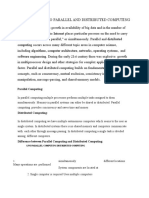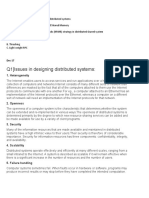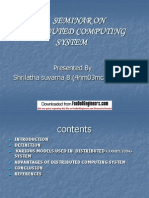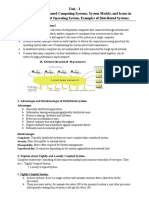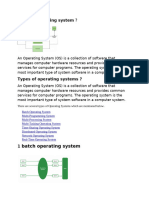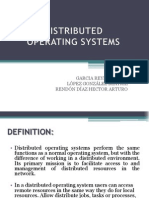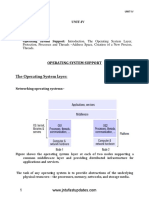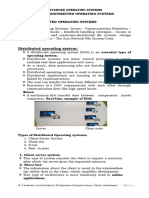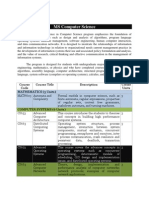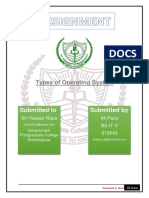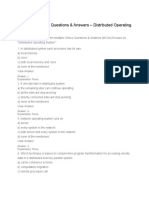PPP
PPP
Uploaded by
James ComedianCopyright:
Available Formats
PPP
PPP
Uploaded by
James ComedianOriginal Title
Copyright
Available Formats
Share this document
Did you find this document useful?
Is this content inappropriate?
Copyright:
Available Formats
PPP
PPP
Uploaded by
James ComedianCopyright:
Available Formats
NAME: JAMES NJUGUNA MUSYOKA
ADM: BITC01/0011/2018
UNIT: DISTRIBUTED SYSTEMS BCIT 3264
YEAR: 3 SEM 2
1. Differentiate between time-sharing, parallel processing, network and distributes
operating
systems?
Time-Sharing Operating Systems is one of the important type of operating system.
Time-sharing
enables many people, located at various terminals, to use a particular computer
system at the same
time. Multitasking or Time-Sharing Systems is a logical extension of
multiprogramming.
Parallel processing is Parallel Processing Systems are designed to speed up the
execution of programs
by dividing the program into multiple fragments and processing these fragments
simultaneously. Such
systems are multiprocessor systems also known as tightly coupled systems. Parallel
systems deal with
the simultaneous use of multiple computer resources that can include a single
computer with multiple
processors, several computers connected by a network to form a parallel processing
cluster or a
combination of both.
The main difference between these two operating systems
(Network Operating System and Distributed Operating System) is that in network
operating system each
node or system can have its own operating system on the other hand in distribute
operating system
each node or system have same operating system which is opposite to the network
operating system.
2. In what respect are distributed computing systems better than parallel
processing systems?
- In parallel computing multiple processors performs multiple tasks assigned to
them simultaneously.
Memory in parallel systems can either be shared or distributed. Parallel computing
provides
concurrency and saves time and money.
In parallel computing environments, the number of processors you can add is
restricted.
This is because the bus connecting the processors and the memory can handle a
limited
number of connections. There are limitations on the number of processors that the
bus
connecting them and the memory can handle. This limitation makes the parallel
systems less scalable.
Distributed computing environments are more scalable. This is because the computers
are connected over the network and communicate by passing messages.
In systems implementing parallel computing, all the processors share the same
memory.
They also share the same communication medium and network. The processors
communicate
with each other with the help of shared memory.
Distributed systems, on the other hand, have their own memory and processors.
- In parallel systems, all the processes share the same master clock for
synchronization.
Since all the processors are hosted on the same physical system, they do not need
any
synchronization algorithms.
In distributed systems, the individual processing systems do not have access to any
central clock. Hence, they need to implement synchronization algorithms
- Parallel computing is often used in places requiring higher and faster processing
power. For example, supercomputers.
Since there are no lags in the passing of messages, these systems have high speed
and
efficiency.
Distributed computing is used when computers are located at different geographical
locations.
In these scenarios, speed is generally not a crucial matter. They are the preferred
choice when scalability is required.
4. Discuss the main guiding principles that a distributed operating system designer
must keep
in mind for good performance of the system?
1. Transparency: One main aim of DOS is to display the existence of multiple
computers as invisible
and provide a single system image to users.
2. Reliability: This is possible in DOS due to the existence of multiple instances
of resources.
A fault may occur generating an error. System failures could either be fail-stop
where system stops
functioning after changing to a state in which a failure can be detected or
Byzantine failure where
system continues to function but produces wrong results.
3. Flexibility: allows the following to be achieved:
i. Ease of modification – incorporating changes in a user-transparent manner or
with minimum
interruption on users.
ii. Ease of enhancements – e.g. adding new functionalities from time to time
to make it more powerful and easy to use.
4. 4. What are the major issues of designing a Distributed OS?
(i) Heterogenety - The Internet enables users to access services and run
applications over
a heterogeneous collection of computers and networks.Internet consists of many
different
sorts of network their differences are masked by the fact that all of the computers
attached
to them use the Internet protocols to communicate with one another.For eg., a
computer
attached to an Ethernet has an implementation of the Internet protocols over the
Ethernet,
whereas a computer on a different sort of network will need an implementation of
the Internet
protocols for that network.
(ii) Security - Many of the information resources that are made available and
maintained
in distributed systems have a high intrinsic value to their users.Their security is
therefore
of considerable importance.
Security for information resources has three components: confidentiality,
integrity,
and availability.
(iii) Scalability - Distributed systems operate effectively and efficiently at
many
different scales, ranging from a small intranet to the Internet. A system is
described
as scalable if it will remain effective when there is a significant increase in the
number of resources and the number of users.
(iv) Cocurrency - Both services and applications provide resources that can be
shared
by clients in a distributed system. There is therefore a possibility that several
clients will attempt to access a shared resource at the same time. Object that
represents
a shared resource in a distributed system must be responsible for ensuring that it
operates
correctly in a concurrent environment.
(v) Transparency - Transparency can be achieved at two different levels. Easiest
to do
is to hide the distribution from the users. The concept of transparency can be
applied to
several aspects of a distributed system.
5. What is the major difference between Network OD and Distributed OS?
- Network Operating System’s main objective is to provide the local services to
remote client while
Distributed Operating System’s main objective is to manage the hardware resources.
- In Network Operating System, Communication takes place on the basis of files
while In
Distributed Operating System, Communication takes place on the basis of messages
and shared memory.
- Network Operating System is more scalable than Distributed Operating System while
Distributed Operating System is less scalable than Network Operating System.
- Rate of autonomy in Network Operating System is high while While The rate of
autonomy in Distributed Operating System is less.
- Ease of implementation in Network Operating System is also high while While in
Distributed
Operating System Ease of implementation is less.
6. Why is scalability an important feature in the design of a distributed OS?
Discuss the
guiding principles for designing a scalable distributed system?
-Scalability is an essential component of enterprise software. Prioritizing it from
the
start leads to lower maintenance costs, better user experience, and higher agility.
A system is considered scalable when it doesn’t need to be redesigned to maintain
effective
performance during or after a steep increase in workload.
“Workload” could refer to simultaneous users, storage capacity, the maximum number
of transactions
handled, or anything else that pushes the system past its original capacity.
Scalability isn’t a basic requirement of a program in that unscalable software can
run well with
limited capacity.
You might also like
- DS Answer PDFDocument79 pagesDS Answer PDFBirat KarkiNo ratings yet
- Cloud Computing NotesDocument98 pagesCloud Computing NotesChikkalaNaiduNo ratings yet
- Introduction To Parallel and Distributed ComputingDocument29 pagesIntroduction To Parallel and Distributed ComputingBerto ZerimarNo ratings yet
- Unit 1 NotesDocument31 pagesUnit 1 NotesRanjith SKNo ratings yet
- DC Notes - 2 MarksDocument11 pagesDC Notes - 2 MarksAlima NasaNo ratings yet
- Distributed System IMP APYDocument210 pagesDistributed System IMP APYAryan PanchalNo ratings yet
- DS Unit-1Document31 pagesDS Unit-1ambatipudi praisy prasannaNo ratings yet
- Cs8603 Unit 1 IntroductionDocument51 pagesCs8603 Unit 1 IntroductionSasi BalajiNo ratings yet
- Chapter 1Document117 pagesChapter 1snekarki80No ratings yet
- Unit-4 Operating SystemsDocument13 pagesUnit-4 Operating SystemsRohit ChaudharyNo ratings yet
- Distributed ComputingDocument40 pagesDistributed Computing014 CSE Devamruth AGNo ratings yet
- CH 1 Distributed SystemDocument12 pagesCH 1 Distributed Systemlucifer27meNo ratings yet
- Distributed Processing SystemsDocument5 pagesDistributed Processing SystemsVincent John Agustin AlipioNo ratings yet
- CH 1 Distributed SystemDocument13 pagesCH 1 Distributed SystemDesire MaharjanNo ratings yet
- Introduction To Distributed SystemsDocument45 pagesIntroduction To Distributed Systemsaderaj getinetNo ratings yet
- DS Unit 1Document13 pagesDS Unit 1Komal GargNo ratings yet
- Types of Operating SystemsDocument12 pagesTypes of Operating SystemsRaja AnsNo ratings yet
- Lec-1-Distributed Operating System Why When HowDocument6 pagesLec-1-Distributed Operating System Why When HowDA AlSSSNo ratings yet
- Chapter (1) Introduction To Distributed SystemsDocument15 pagesChapter (1) Introduction To Distributed Systemsalaaelsokary050No ratings yet
- Course Title: Introduction To Distributed System Chapter 1: Introduction To Distributed SystemDocument21 pagesCourse Title: Introduction To Distributed System Chapter 1: Introduction To Distributed SystemYilmaNo ratings yet
- Unit 4 OsDocument21 pagesUnit 4 Osdivine rockyNo ratings yet
- Q1) Issues in Designing Distributed Systems:: 1. HeterogeneityDocument3 pagesQ1) Issues in Designing Distributed Systems:: 1. HeterogeneitySubhadeepti GantiNo ratings yet
- Week 1Document22 pagesWeek 1samuelsilas123456789No ratings yet
- PII Distr Syst Note en v2Document109 pagesPII Distr Syst Note en v2Cosmina IvanNo ratings yet
- 555 PGDocument49 pages555 PGbivakarmahapatra7872No ratings yet
- Distributed S Notes 240228 144257Document69 pagesDistributed S Notes 240228 144257Victor KirimiNo ratings yet
- Introduction To Distributed SystemsDocument25 pagesIntroduction To Distributed SystemsshabinmohdNo ratings yet
- Introduction To Distributed SystemsDocument5 pagesIntroduction To Distributed SystemsoljiraaNo ratings yet
- Design of Parallel and Distributed Systems: Dr. Seemab LatifDocument36 pagesDesign of Parallel and Distributed Systems: Dr. Seemab LatifNadi YaqoobNo ratings yet
- Z-Distributed Computing)Document16 pagesZ-Distributed Computing)Surangma ParasharNo ratings yet
- اسيمنتاتDocument48 pagesاسيمنتاتابراهيم اشرف ابراهيم متولي زايدNo ratings yet
- CSE 423 Virtualization and Cloud Computinglecture0Document16 pagesCSE 423 Virtualization and Cloud Computinglecture0Shahad ShahulNo ratings yet
- Comparative Study of DOS and NOSDocument22 pagesComparative Study of DOS and NOSBhushan JadhavNo ratings yet
- DC Unit 1Document48 pagesDC Unit 1Andrea FernandesNo ratings yet
- Lecture 2Document9 pagesLecture 2huzaifazafi593No ratings yet
- Distributed Operating SystemDocument18 pagesDistributed Operating SystemRajni ShelkeNo ratings yet
- Unit IDocument8 pagesUnit Ivenkata rama krishna rao junnuNo ratings yet
- 03-Real Time and Distributed Computing Systems - 4paginasDocument4 pages03-Real Time and Distributed Computing Systems - 4paginasespinheirontNo ratings yet
- 01 - Introduction To Distributed SystemsDocument5 pages01 - Introduction To Distributed SystemsPeterArnoldNo ratings yet
- Distributed Database Systems: Assignment 1Document6 pagesDistributed Database Systems: Assignment 1Muhammad IrfanNo ratings yet
- Questions To Practice For Cse323 Quiz 1Document4 pagesQuestions To Practice For Cse323 Quiz 1errormaruf4No ratings yet
- CS02DOS Unit 1UNit - 1 IntroductionDocument6 pagesCS02DOS Unit 1UNit - 1 IntroductionSalar AhmedNo ratings yet
- Batch Operating SystemDocument3 pagesBatch Operating SystemAgrippa Mungazi100% (1)
- DDBSDocument19 pagesDDBSBudhaditya MukherjeeNo ratings yet
- CSC - 406 - 1 - Intro To Distributed SystemDocument22 pagesCSC - 406 - 1 - Intro To Distributed SystemSamadNo ratings yet
- Distributed System Assignment-1: Jimma UniversityDocument9 pagesDistributed System Assignment-1: Jimma UniversityadmachewNo ratings yet
- Cloud Aasigment1&2Document30 pagesCloud Aasigment1&2Madhuri DesaiNo ratings yet
- Lecture 1 Introduction To Distributed Systems - 034922Document6 pagesLecture 1 Introduction To Distributed Systems - 034922leonardkigen100No ratings yet
- CHAPTER1 UpdateDocument20 pagesCHAPTER1 Updatemd5fxz9thsNo ratings yet
- DC-Unit 1Document9 pagesDC-Unit 1Andrea FernandesNo ratings yet
- Mulugeta A.: Chapter OneDocument57 pagesMulugeta A.: Chapter Onemerhatsidik melkeNo ratings yet
- 1-1 Into To Distributed SystemsDocument10 pages1-1 Into To Distributed SystemsHarrison NchoeNo ratings yet
- Maahi Shah 24se02ds013 PR 03Document9 pagesMaahi Shah 24se02ds013 PR 03maahijain093No ratings yet
- Challenges For A Distributed System: 1. HeterogeneityDocument7 pagesChallenges For A Distributed System: 1. HeterogeneityDesire MaharjanNo ratings yet
- Rohini 89923516027Document6 pagesRohini 89923516027tbitNo ratings yet
- Chapter OneDocument33 pagesChapter OneUrgessa GedefaNo ratings yet
- Osy MicroprojectDocument11 pagesOsy Microprojecthamza khanNo ratings yet
- Distributed Operating SystemsDocument54 pagesDistributed Operating Systemsbeti_1531No ratings yet
- Types of Operating Systems - GeeksforGeeksDocument12 pagesTypes of Operating Systems - GeeksforGeeksAvin MannNo ratings yet
- Operating Systems: Concepts to Save Money, Time, and FrustrationFrom EverandOperating Systems: Concepts to Save Money, Time, and FrustrationNo ratings yet
- Unit - 1 Architecture of Distributed SystemsDocument22 pagesUnit - 1 Architecture of Distributed SystemsAnjna SharmaNo ratings yet
- PPPDocument4 pagesPPPJames ComedianNo ratings yet
- 3 History Evaluation and Types of OSDocument12 pages3 History Evaluation and Types of OSMannNo ratings yet
- 4-5 Distributed Operating Systems Concepts and Principles + Comparison of NOS and DOSDocument43 pages4-5 Distributed Operating Systems Concepts and Principles + Comparison of NOS and DOSDr. Atta ur Rehman KhanNo ratings yet
- MODULE 1 RTOS PPT (1)Document60 pagesMODULE 1 RTOS PPT (1)joyalgigi799No ratings yet
- Ds r16 - Unit-4 (Ref-2)Document15 pagesDs r16 - Unit-4 (Ref-2)Hemanth SankaramanchiNo ratings yet
- Distributed Operating Systems: Unit - 2Document48 pagesDistributed Operating Systems: Unit - 2eyasuNo ratings yet
- Unit 5 - Operating System - WWW - Rgpvnotes.inDocument27 pagesUnit 5 - Operating System - WWW - Rgpvnotes.inGirraj DohareNo ratings yet
- Unit 2 Advanced Operating Systems 23pcsce24!3!1Document17 pagesUnit 2 Advanced Operating Systems 23pcsce24!3!1Friends of GADGETSNo ratings yet
- OSY Notes Vol 1 - Ur Engineering FriendDocument68 pagesOSY Notes Vol 1 - Ur Engineering FriendSameer TembhareNo ratings yet
- Distributed Operating SystemDocument5 pagesDistributed Operating SystemVarunNo ratings yet
- Distributed Operating SystemDocument57 pagesDistributed Operating SystemSAI RAMANNo ratings yet
- Osy Microproject (Final)Document14 pagesOsy Microproject (Final)Pŕëm ÇĥüñïÿäṅNo ratings yet
- Module 3 - SoftwareDocument10 pagesModule 3 - SoftwareRoden LacabaNo ratings yet
- Operating System: Operating Systems: Internals and Design PrinciplesDocument86 pagesOperating System: Operating Systems: Internals and Design PrinciplesJeremiah FerrerNo ratings yet
- BCA 1ST YEAR (Unit-1)Document37 pagesBCA 1ST YEAR (Unit-1)ghatiyashivani48No ratings yet
- Unit 1 - Distributed System - WWW - Rgpvnotes.inDocument19 pagesUnit 1 - Distributed System - WWW - Rgpvnotes.innitesh kumar100% (2)
- Chapter-4-THEORETICAL CONCEPTS OF OPERATING SYSTEMDocument6 pagesChapter-4-THEORETICAL CONCEPTS OF OPERATING SYSTEMvenusrinivassNo ratings yet
- MS Computer Science - Mapua - CurriculumDocument3 pagesMS Computer Science - Mapua - CurriculumMhel ZamoraNo ratings yet
- On Distributed OsDocument131 pagesOn Distributed OssejalcjadhavNo ratings yet
- Operating System AssignmentDocument16 pagesOperating System AssignmentGhoSty BhooT0% (1)
- 2016 Summer Model Answer PaperDocument40 pages2016 Summer Model Answer PaperMANGESH BHOSALENo ratings yet
- Distributed Operating System Research Papers PDFDocument6 pagesDistributed Operating System Research Papers PDFuwtsmecndNo ratings yet
- Distributed Operating Systems SyllabusDocument2 pagesDistributed Operating Systems Syllabuslakshay ahujaNo ratings yet
- Mutual Exclusion in Distributed SystemDocument39 pagesMutual Exclusion in Distributed SystemChina Toon100% (1)
- Allama Iqbal Open University, Islamabad (Department of Computer Science) WarningDocument4 pagesAllama Iqbal Open University, Islamabad (Department of Computer Science) Warninggulzar ahmadNo ratings yet
- OS PPTDocument36 pagesOS PPTVatsal Ghoghari100% (1)
- Types of Operating System: Submitted by Submitted ToDocument7 pagesTypes of Operating System: Submitted by Submitted ToAli RazaNo ratings yet
- DS QuizDocument19 pagesDS QuizAkashNo ratings yet
- 19DCE068 OS Practical-1Document17 pages19DCE068 OS Practical-1Anand BapodaraNo ratings yet


